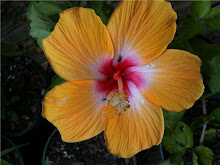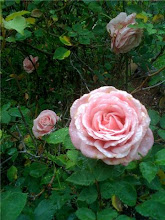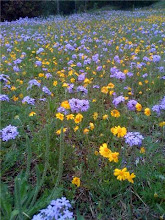Here in the Hill Country (and most of Texas, actually) we've not seen any real rain since last fall. We've had record temperatures and months and months of very hot dry weather. Couple a long drought with hot weather and we have more than dying trees and plants to worry about! We've been experiencing random fires popping up everywhere - all it takes is a careless toss of a lit cigarette or even a car idling in the grass. It's scary.
Just this week we had weather in the 90's and let me tell you - after weeks and weeks of 100+ degrees - the 90's feels pretty darn nice!!
I thought I'd post about our Texas Herb Hero's this evening as I sit in the garden and enjoy the cool northern breeze. These herbs not only sustained the miserable dangerous heat all on their own, with little to no water- they proved that even in the roughest of times you can count on them for medicine and food. Here are a few of the lovely, juicy, delicious and medicinal plants thriving and withstanding hungry deer and brutal weather in the Texas Hill Country:
Briar or Smilax bona-nox: Although this speckled leafed thorny plant looks like it would be too tough to digest, the smooth new shoots and leaves are quite edible and tasty. The young leaves can be enjoyed straight off the vine and tastes a bit like asparagus. You can harvest the young leaves and cook them as well – although some see this thorny plant as a headache – it’s actually quite useful as a food.
The root tubers can also be prepared to improve male fertility as well as easing PMS in women. I plan on harvesting the root and incorporating it into a special salve for skin ailments.
Mullein (Verbascum thapsus): Leaves can be harvested the first year and the flowers can be harvested the second year. It will bloom in its second year. Lighting the leaves and inhaling a bit of the smoke has been an herbal remedy for asthma symptoms as well as respiratory symptoms. The leaves can be infused in water and drunk like a tea to ease a distressed respiratory system and sinus infections. With all the Texas wildfires – this is a good plant to have on hand to help our boost our respiratory systems.
If you follow this blog, you also know I use the leaves in my “Happy Camper” lotion to skin exposed to the elements and from a hard day gardening. The flowers can also be infused in oils to help with ear aches as well as made into salves and lotions for the skin. All parts of this soft and gentle herb can be used: roots and all. It’s a true gift to find one of these plants on the property.
Purslane (Portulaca oleracea): This little plant seems to pop up in potted plants all around my garden. It does very well with little water and brutal sun. The Purslane I have produces small yellow flowers. The juicy red stems are one of its identifying traits. Purslane can be tossed into salads or lightly stir fried with olive oil. It’s a tasty food and keeper in my book!
Finally, let's not forget our long trusty and faithful friend - Cactus. Right now, the fruit, or tunas, are deep deep red and ready to be pureed into something special. Last year, Herbhusband and I made prickly pear margaritas!
Within this dry landscape is our fenced in well tended garden producing flowers and food. It is a spoiled garden heavily dependent on our daily tending in order to thrive. However, it is valuable to know which plants naturally thrive and grow around us - solely dependent on nature and not on human contributions. I enjoy seeing and meeting these wise, strong, medicinal plants as they thrive under these harsh weather conditions. It's as if meeting an elder from centuries past. They seem to share stories of long ago as well as teach the importance of contributing to their land through their perseverance and will to survive.
Autumn's Bounty
2 months ago

















+and+wildflowers+loving+the+field.jpg)








1 comment:
This is great thanks!
Post a Comment